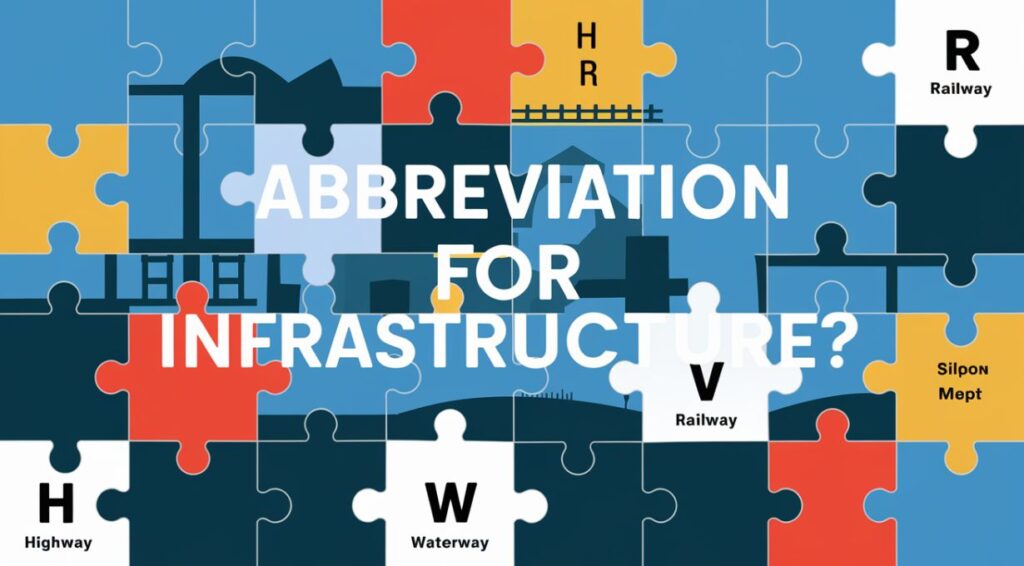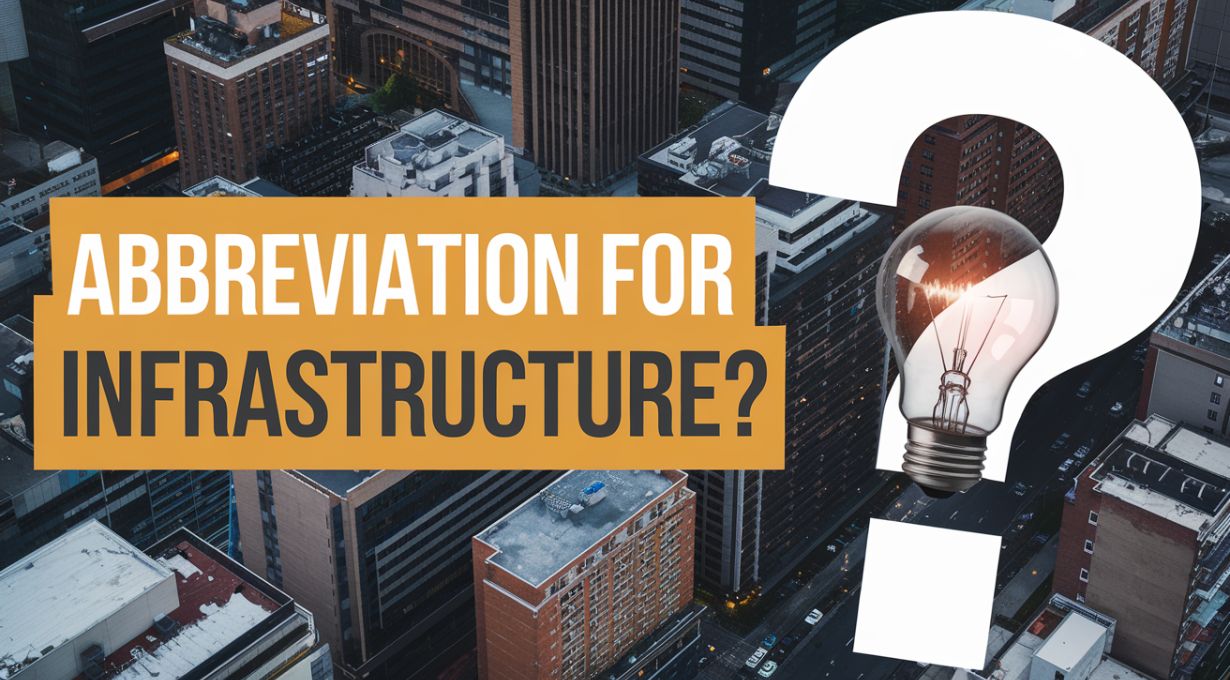Infrastructure is one of those essential yet often overlooked elements that form the backbone of modern societies. From the roads we drive on to the internet networks we depend on for work and entertainment, infrastructure touches nearly every part of our daily lives.
However, when it comes to discussing this broad and multifaceted concept, the word “infrastructure” can sometimes be shortened or abbreviated. But what does this abbreviation really mean, and why is it used? If you’ve ever been curious about how infrastructure is represented in shorthand or how it fits into larger contexts, you’ve come to the right place.
In this article, we’ll dive into the meaning of “infrastructure,” explore its abbreviations, and offer clarity on the role it plays in both everyday life and larger societal systems. Whether you’re just trying to understand the term more deeply or need to get a grip on the acronyms used in conversations about infrastructure, this guide is for you.
What is Infrastructure?

Before we get into the abbreviation and shorthand for infrastructure, it’s important to understand what the term “infrastructure” actually means. At its core, infrastructure refers to the fundamental physical and organizational structures needed for the operation of a society or enterprise. It encompasses a broad range of facilities, services, and systems that support a country, city, or community’s functioning.
Key Types of Infrastructure
- Transportation Infrastructure: This includes roads, highways, railways, airports, and ports—essential for moving people and goods from one place to another.
- Utility Infrastructure: Water, electricity, gas, and waste management systems are all crucial to keeping our daily lives running smoothly.
- Communications Infrastructure: Internet networks, phone lines, and broadcasting systems fall under this category.
- Social Infrastructure: Schools, hospitals, and public buildings that provide vital services to communities.
- Economic Infrastructure: Financial systems, markets, and legal systems that help businesses and governments function effectively.
Why is Infrastructure Important?
The importance of infrastructure cannot be overstated. It affects everything from public health to economic growth, education, and social welfare. Infrastructure is the foundation on which societies build their future, and it plays a role in everything from improving quality of life to fostering innovation. Without robust infrastructure, the wheels of a country would grind to a halt.
Abbreviation for Infrastructure: What Does It Mean?
When it comes to the abbreviation for “infrastructure,” there isn’t one universal short form, but several ways it might be abbreviated in specific contexts. The abbreviation often depends on the industry or area of discussion. Let’s look at some of the more common abbreviations for infrastructure and why they’re used.
1. Infra.: The Most Common Abbreviation
One of the most straightforward abbreviations for infrastructure is simply “Infra.” This shorthand is commonly used in academic, governmental, and industry discussions, particularly when referring to large-scale infrastructure projects or systems. For example, a report might refer to “Infra. projects” or “Infra. development” when talking about public works such as bridges, roads, and utility systems.
Example Sentence:
- “The government has allocated significant funds to improve Infra. in rural areas.”
2. IT Infrastructure (IT Infra.): A Specialized Form
In the realm of technology and business, “IT Infra.” or “IT Infrastructure” is frequently used to describe the technological infrastructure that supports businesses. This encompasses hardware (servers, computers), software, networks, and data storage systems that enable businesses to function in the digital age.
Example Sentence:
- “The company invested in upgrading its IT Infra. to improve data security and user experience.”
3. InfraTech: Infrastructure Technology
In more recent discussions, especially in tech and innovation circles, the term InfraTech has emerged as a shorthand for Infrastructure Technology. This refers to the use of advanced technologies to improve or enhance traditional infrastructure systems. Examples include smart grids for energy distribution or data-driven transportation systems.
Example Sentence:
- “InfraTech companies are revolutionizing how cities manage traffic, water, and energy consumption.”
Why Use Abbreviations for Infrastructure?

Abbreviations are often used for convenience and efficiency. In industries where infrastructure is a primary focus, such as urban planning, civil engineering, and technology, shorthand terms allow professionals to communicate more quickly and clearly. Let’s look at some reasons why abbreviations for infrastructure might be particularly useful.
1. Ease of Communication
In sectors like construction and city planning, projects can span years, involve countless people, and require constant updates. Abbreviating terms like “infrastructure” makes it easier for professionals to refer to ongoing work without needing to constantly use the full term. Shortened terms like “Infra.” become a sort of shorthand that streamlines communication in meetings, reports, and documents.
2. Space and Time Constraints
In written forms, especially in documents, reports, or presentations, space and time are often limited. Using abbreviations allows for more concise messaging without losing meaning or context. The term “Infra.” is particularly useful in documents or projects where space is limited, such as slide presentations or data sheets.
3. Focusing on Specific Sectors
In fields like Information Technology (IT), separating the different types of infrastructure—like IT Infra.—helps professionals focus on particular sectors. This makes it easier for specialists to target their discussions and research to specific areas like network design or server infrastructure, without generalizing the term to all types of infrastructure.
Where are Abbreviations for Infrastructure Used?
Abbreviations for infrastructure aren’t limited to just government, academic, or technical environments. They’re also commonly used in discussions related to:
1. Urban Planning and Development
Urban planners and civil engineers often use abbreviations for infrastructure to refer to projects and systems they’re working on. In city planning meetings, it’s not uncommon for professionals to use terms like “Infra. projects” to describe large-scale transportation or utility initiatives that will impact an entire population.
Example: “The city’s Infra. development is set to boost its economic viability in the next decade.”
2. Technology and Business
In the tech world, abbreviations like “IT Infra.” are crucial for discussing the digital backbone of organizations. IT professionals use this abbreviation to talk about the systems that ensure everything from cloud computing to cybersecurity works efficiently. Businesses also use these terms to simplify discussions about technology investments.
Example: “Our company’s IT Infra. needs to be upgraded to handle the new software deployment.”
3. Government and Policy
Abbreviations such as “Infra.” are frequently used in policy documents, especially when discussing government spending, public works projects, or national development strategies. Abbreviating infrastructure in such cases allows policymakers to efficiently communicate complex plans for public works and economic growth.
Example: “The new legislation focuses heavily on funding Infra. initiatives to improve public transportation.”
Important Considerations When Using Abbreviations for Infrastructure
While abbreviations can make communication more efficient, it’s important to consider your audience. For example, someone who isn’t familiar with infrastructure terminology might get confused if you suddenly use terms like “Infra.” without providing context. Always make sure your audience can follow along, especially if you’re writing for people outside of a specialized field.
1. Know Your Audience
If you’re in an industry where these terms are commonly understood, abbreviating infrastructure terms is perfectly acceptable. However, if you’re speaking to a broader or non-technical audience, it’s important to clarify the meaning of these abbreviations upfront.
2. Be Clear and Specific
Sometimes, the term “infrastructure” can be used in a variety of contexts. If you’re using abbreviations, be sure to specify which type of infrastructure you’re referring to (e.g., IT Infra., public Infra., etc.) so your message remains clear and focused.
Final Words
Abbreviations for infrastructure, such as “Infra.”, “IT Infra.”, or even “InfraTech,” are useful shorthand that help professionals communicate more efficiently across various fields. Whether you’re working in urban planning, technology, or public policy, these abbreviations allow for quick, streamlined conversations about complex systems.
It’s important to understand the meaning behind these abbreviations and when they are used—this ensures clear communication, whether you’re drafting a report, giving a presentation, or discussing infrastructure projects with colleagues. The key takeaway here is that while abbreviations make it easier to communicate, the full understanding of what infrastructure encompasses remains essential, no matter how it’s abbreviated.
So next time you encounter an abbreviation for infrastructure, you’ll know exactly what it stands for—and why it’s being used. Whether you’re a professional or just someone trying to keep up with modern terms, understanding infrastructure and its shorthand can only help you stay ahead of the curve.









